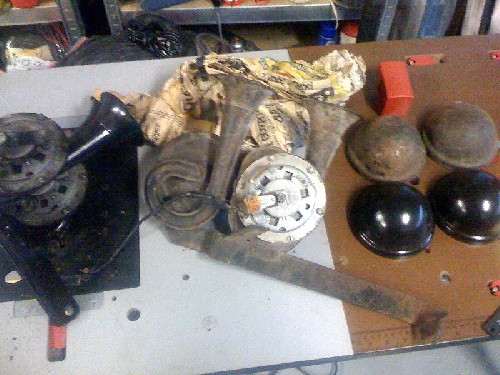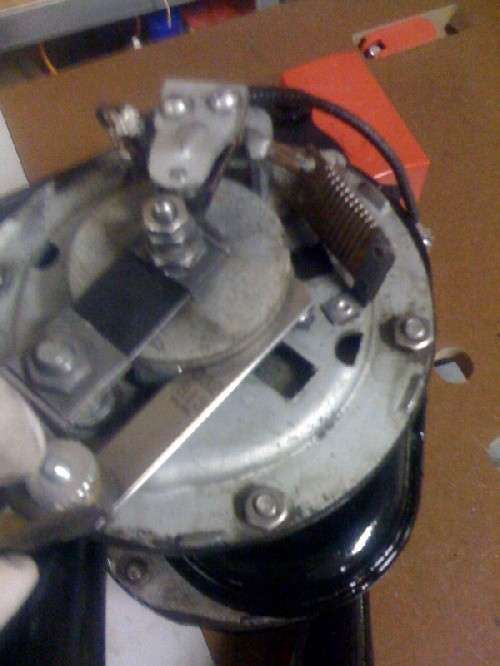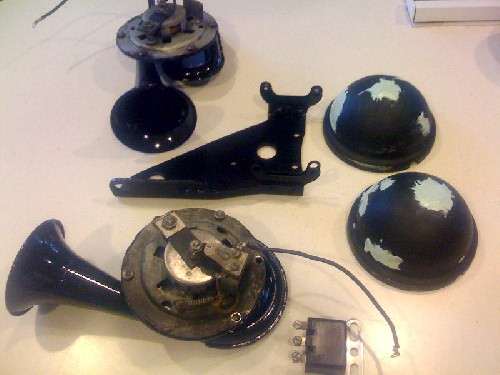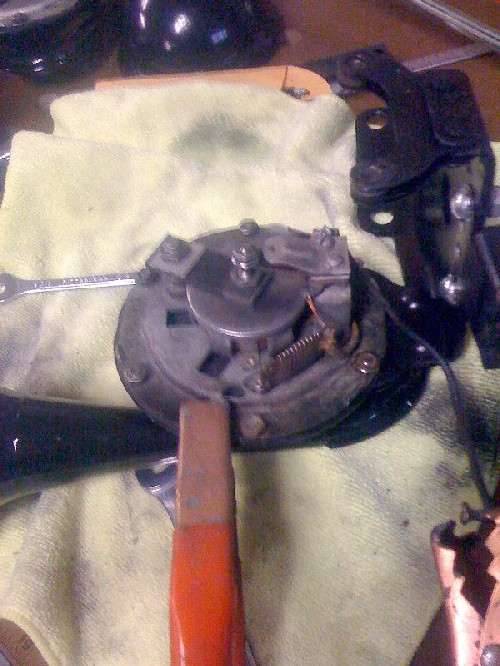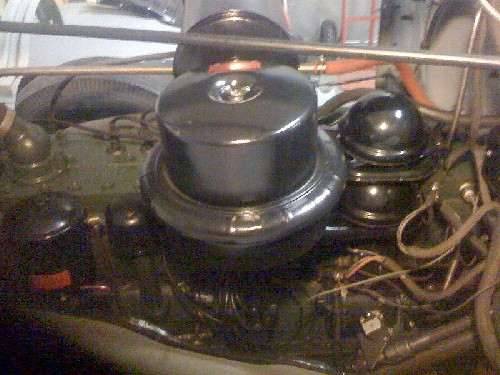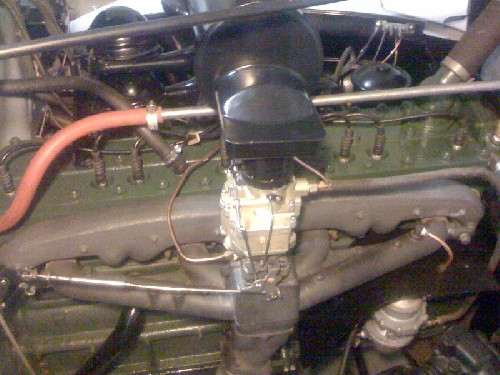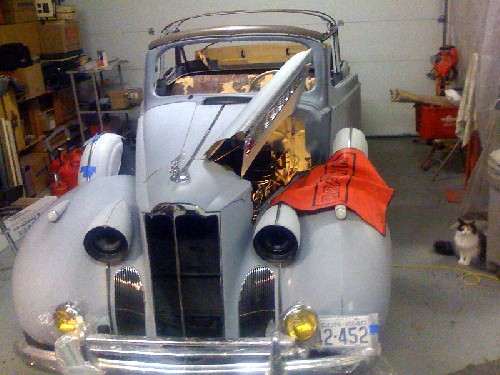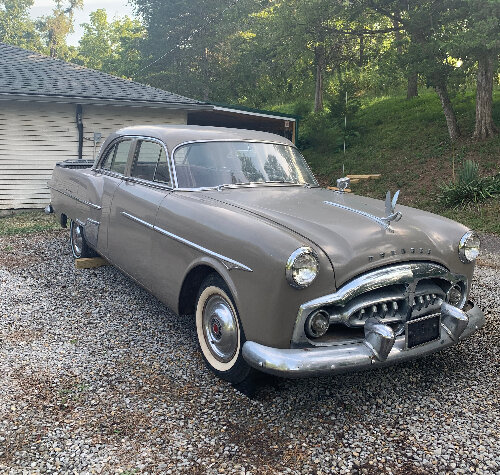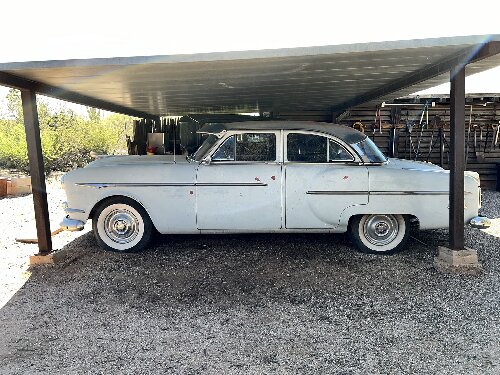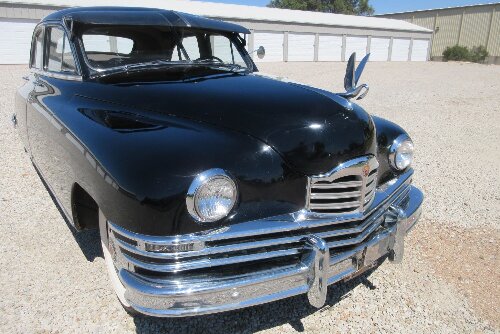|
Re: The Duchess Project: 1940 Super 8 Convertible Sedan
|
||||
|---|---|---|---|---|
|
Forum Ambassador

|
In 1941 there was a Senior color combo that I've admired on open cars, and it was (I believe) the only one where the wheel color was contrasting and not the same as body color or colors (if two-toned), and I think to a large extent that made the combo attractive. Don't know if you care about such details as correctness for your year or not, but the combo was Saratoga Beige with Cimmaron Red wheels. Interior was a combo of red leather and beige Bedford Cord. Tan Haartz cloth top and boot.
See picture (about halfway down the page parked at a train station @http://restoredrustyrelics.com/MemberCarPhotos.aspx It's a 1941 160DE.
Posted on: 2011/3/11 14:36
|
|||
|
||||
|
Re: The Duchess Project: 1940 Super 8 Convertible Sedan
|
||||
|---|---|---|---|---|
|
Home away from home
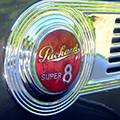
|
HORNS:
Forgot to add the link to the best information I found for redoing the horns besides p.22 of the 1938-39 Shop Manual: http://www.vernco.com/Sparks/id516.htm While waiting for the carburetor kit from The Carburetor Shop and for Merle to rebuilt it, I've been working on the horns. After doing a lot of research trying to find horn info, I couldn't find my Sparton horns, but they generally all work on the same principle. One horn had not honked since the 1970s. I tried to fix it then and broke the long center post screw with the adjusting nuts at the top. You pretty much need another horn for parts in order to fix it, so it wasn't fixed. When I connected the horns to the car battery with my leads, they barely groaned. I bought a pair of rusted out horns what I first started working on the car. This week I unwrapped them from 1987 newspaper. They looked like they were in bad shape, but actually the essential electrical and vibration parts were fine. I took one apart and replaced the thin large disc attached to the long center post that had been broken. I took everything apart and cleaned, blowing air through them with the compressor. I found a note in my 1940 Prelim shop manual that adjusting the horns and settings were in the 1938-39 Shop Manual, which is online here. The horns are held to the bracket on springy metal crescents attached to the bracket by very heavy duty 1/4 " rivets. These were also broken, so removed the ones from the crusty horns and reinstalled them on the bracket. The shell covers were dinged up, so glazed them and painted everything exterior. They should toot now, right? They didn't. They wouldn't even groan. I discovered that the insulating tubes surrounding the two very top screws that hold the sandwich of metal plates and insulation, the top layers being the points that open and close, weren't doing their job. I tried to reuse them but in trying to press them back in place I messed them up. I bought some shrink tubing, slipped that around them warmed with a hairdryer. That restored the insulation, but still no toot. I called Bruce Abbott, Abbott Instruments, even though he had told me he didn't play with horns much. He did a beautiful job restoring all my dash instruments. But I called anyway to see if he would check them out, see if I didn't anything illogical circuit-wise. He suggested, before I bring them over to try a couple more things. One is to make sure the leads are heavy gauge because horns pull a lot of amps and if the leads aren't heavy enough they won't start vibrating. Two was to loosen everything up and hit them with a rubber mallet to get them to start vibrating. Taking no chances I used my battery jumper cables as leads. It killed me after fussing over these horns, but I tapped and, when that didn't do any damage, and I started to hear a crackle of noise, I hit them a few times. Wow, I got one genuine honk. I loosened the nut that holds the armature, that thick cookie-sized disc, and turned it against my feeler gauge, one horn to .028 in. and the other to .034 in. Now I was getting more honking. I turn the adjusting nut at the top and it got better. Now both horns honk, hallelujah! WHERE ON THE ENGINE? I spend most of today trying to figure out where the horn bracket attaches to the engine. It looks like it should attach to two head studs direct across from one another. I tried re-position the coil, the air cleaner bracket. The heater hose inlets were in the way. The overdrive relay was in the way in another position. I just couldn't figure it out. Putting that question out for help in the pre-war forum.
Posted on: 2011/3/20 23:18
|
|||
|
||||
|
Re: The Duchess Project: 1940 Super 8 Convertible Sedan
|
||||
|---|---|---|---|---|
|
Home away from home

|
A SCIENTERRIFIC WEEKEND
HORN INSTALL: There's a theory of physics that says No two objects can occupy the same place at the same time, with one exception. The horns, oil bath air cleaner, spark plug wire holder, and coil of a '40 Super 8 engine. On the '40 356 engine there are two bolt holes just in front of the 3rd head stud from the rear on the left side of the engine. Attaching the horns here instantly worked, with very little clearance. ENGINE START: It's been a huge source of frustration that the engine, beautiful as it looks, won't start or run very long without konking out if it does. Friday night I decided to use the scientific method to determine why the engine wouldn't start, so I went to bed early. Saturday morning I mapped out each item I'd check, no matter how elemental. No assumptions! I started with the gas tank. I opened the plug, gas poured out. I had already changed the in line filter close to the tank. The old one was filthy. I moved to the front of the car and loosened the intake hose of the fuel pump. Nothing came out. I remember my uncles sucking on a line to get gas flowing to the tractor. I wasn't going to do that. I used the shop vac. Probably pretty dangerous when I thought about it later. Just put my hand between the hose opening and the vacuum hose end so I could feel anything coming through. Bloop. Something came out, bubbly and a little oily, followed by gas. Could it be this simple? I didn't prime the carb, just use the starter. Psst. Several revs and she roared into fast idle. Warmed up and idled down to nothing without dying. Ever since the tow truck backed it off last year, it was pointed outward, so the exhaust went into the garage. When the rain stopped, I backed it out, turned it around and, boy, am I a happy camper. Next step is to find a few more missing pieces. Get those ready and have 2 of my grandchildren, Tim and Kate, come over and 'rip it apart.' Everything is finger tight, so we'll take it apart, back and label fasteners and take to Canyon Auto's new $100,000 paint booth. But I'm getting ahead of myself. Gee, one little blob.
Posted on: 2011/3/28 14:08
|
|||
|
||||
|
Re: The Duchess Project: 1940 Super 8 Convertible Sedan
|
||||
|---|---|---|---|---|
|
Forum Ambassador
|
Congratulations. That little bloob wasn't made of cut leaf pieces was it. We have some kind of insect locally that will find open tubing of any sort around that diameter no matter what was in it before and either lay an egg or make a cocoon. Sometimes you can see them but usually they're an inch or so down and if you forget to look, not found until one goes thru what you did.
Posted on: 2011/3/28 14:28
|
|||
|
Howard
|
||||
|
||||
|
Re: The Duchess Project: 1940 Super 8 Convertible Sedan
|
||||
|---|---|---|---|---|
|
Home away from home

|
I think you're right. I had put some gum out and marvel oil in the gas. I thought maybe that jelled or something.
Something came out but got washed away in gas that followed and I wiped it up right away. But yes, the gas tank was removed to make it safe to weld the floor and brackets for the trunk. It sat out at the farm for a couple years while that and other parts were worked on, so some little creature could have crawled up the empty gas line. Next time, I'll tape it.
Posted on: 2011/3/28 14:40
|
|||
|
||||
|
Re: The Duchess Project: 1940 Super 8 Convertible Sedan
|
||||
|---|---|---|---|---|
|
Home away from home
|
Joe, noticed in your photo of the engine complete left back that there is no tube to direct fan air into the crankcase breather. Also, the breather sits below the oil filter and is further hidden from the fan blast. Is this how the '40 356s are or did the taller breather and tube come later? I was of the understanding that crankcase ventilation was critical on these engines. Just an observation. By the way, things are really shaping up nicely. Thanks for sharing.
(o{I}o)
Posted on: 2011/3/28 21:56
|
|||
|
We move toward
And make happen What occupies our mind... (W. Scherer) |
||||
|
||||
|
Re: The Duchess Project: 1940 Super 8 Convertible Sedan
|
||||
|---|---|---|---|---|
|
Forum Ambassador
|
Sticking and rusty valves was the issue and first mention of installing the longer fill tube was in Feb 41 service counselor. A couple of reminders in 42 and a new cap and another in 43. Sludge buildup also caused by poor ventilation mentioned in 43. There was also an article introducing the tube in the airstream to direct the air past the filter to the cap but don't see if offhand to catch the date.
Posted on: 2011/3/28 22:50
|
|||
|
Howard
|
||||
|
||||
|
Re: The Duchess Project: 1940 Super 8 Convertible Sedan
|
||||
|---|---|---|---|---|
|
Home away from home

|
JW and Howard, Once again, thanks for the info. The evolution of the 356 over 10 years is always interesting, like going through the business with getting oil to the lifters. What was funny is we went through all the rigmarole to add that pipe and I think a larger hole was drilled, only to discover, because it's a 47-48, all that had be done and the oil flow had been changed to go in the opposite direction through the filter. So I went though the evolutionary steps, sort of.
I want to continue experiencing all the stages of metamorphosis. Actually I have the longer filler tube and the flatter, larger diameter cap. But looking at the 1940 engines, they just didn't have those. For $10 I bought a 1940 crusted tube and cap rusted together. I removed the rust using electrolysis with washing soda and my battery charger because I wanted to try it. It worked. I got them apart. Sanded and primed and sanded and glazed and painted and sanded and painted. They look beautiful now. You want to tell me to put the "old" newer version back on the engine? Just because of a little sludge build up? You know how happy I'd be if I could get to the point where I could have some sludge build-up? I'm going to do this authentically. When I hit the road, it will be like August 1939. I'm going to drive for a year and a half to the equivalent of Feb 1941. Then I'm going to change the tube and cap.That's as authentic as I can get. You make this fun.
Posted on: 2011/3/29 1:19
|
|||
|
||||
|
Re: The Duchess Project: 1940 Super 8 Convertible Sedan
|
||||
|---|---|---|---|---|
|
Home away from home
|
The draft tube and vented oil filler cap cam about for the 1941 model year.
I wouldn't worry too much about sludge build up since you probably won't be driving more than a few thousand miles per year, with yearly oil changes.
Posted on: 2011/3/29 8:20
|
|||
|
West Peterson
1930 Packard Speedster Eight Runabout (boattail) 1940 Packard 1808 w/Factory Air 1947 Chrysler Town and Country sedan 1970 Camaro RS https://packardinfo.com/xoops/html/modules/newbb/viewtopic.php?topic_id=4307&forum=10 http://aaca.org/ |
||||
|
||||

 (72.98 KB)
(72.98 KB)